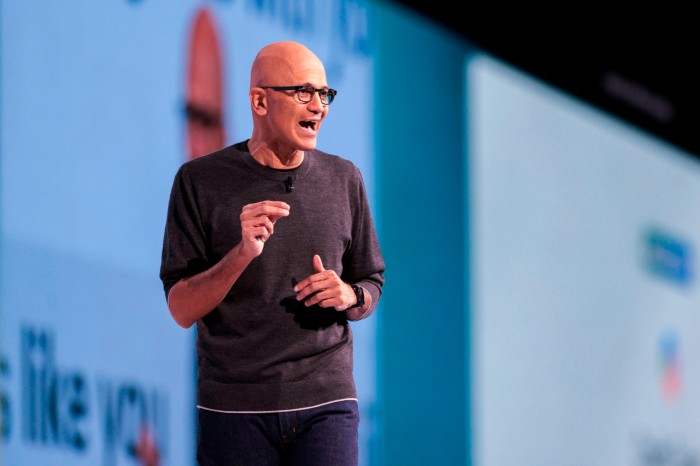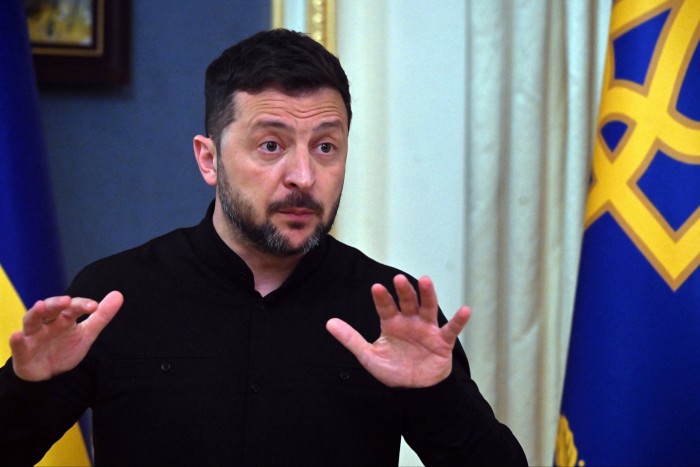‘Microsoft is the AI ringleader’: tech rivals flock to software giant’s stage

Microsoft sought to tighten its grip on the artificial intelligence industry this week, unveiling a raft of new products and partnerships with OpenAI, Nvidia and Elon Musk’s xAI in a bid to emerge a winner among those profiting from the cutting-edge technology.
The $3.4tn tech giant held its annual Build conference in Seattle, where it revealed a series of AI-related advances, including a powerful coding “agent” that works using simple instructions and a tool for businesses to build and manage multiple of these digital assistants.
Another striking feature of the three-day conference was virtual appearances from tech titans such as OpenAI chief Sam Altman, Musk and Nvidia chief Jensen Huang.
Their presentations at Build reflect how the fortunes of AI groups have become inextricably tied to Microsoft, a 50-year-old company that fumbled the advent of mobile but is positioning itself at the heart of the AI sector under the leadership of Satya Nadella.
Each needs Microsoft to help sell AI models to business customers who use its Azure cloud computing infrastructure, developer tools and productivity software.
“It’s not about any one tool, any one agent or any one form factor,” said Nadella on Monday. “This is a platform that we want to create together . . . I think something big is going to shake out of this because this is not just a repeat of the past.”
Musk, who is suing Microsoft over its roughly $14bn partnership with OpenAI, promised Nadella’s customers that their feedback would influence the direction of xAI’s Grok family of models after signing a deal to offer them on the company’s Azure Foundry platform. “Tell us what you want, and we’ll make it happen,” he said.
Huang later told the more than 3,000 attendees at the conference that the two technology giants were together “building the largest AI supercomputer in the world”, referring to the deployment of Nvidia’s advanced chips in Microsoft’s data centres.
Altman said OpenAI’s Codex coding agent “integrates very deeply” with the computer programming tool made by Microsoft’s GitHub unit.
“Microsoft is the AI ringleader. It is the pre-eminent platform, catalyst and orchestrator for making models work,” said Kash Rangan, an analyst at Goldman Sachs. “If it wins, they get to win.”

Nadella said the technology industry was in the middle of “another platform shift” — a radical change of which technical innovation is used to create new goods and services, similar to how the internet transformed how businesses and individuals live and work.
Investors are betting Microsoft is well placed to exploit the shift. The company’s share price has risen more than 8 per over 2025 on the back of market confidence over its AI plans.
By contrast, shares in most of the “Magnificent Seven” US Big tech stocks have fallen since the start of the year as the shock of Donald Trump’s tariffs weighed on the US stock market.
The Redmond, Washington-based group stole a march on rivals when OpenAI launched ChatGPT in 2022, adding to its investment in the San Francisco-based start-up while integrating the group’s models into Microsoft products such as its Copilot AI assistant.
But it has also worked to offer an array of services to customers. Despite integrating OpenAI’s Codex into GitHub Copilot, Nadella’s team this week announced a deal to offer rival Anthropic’s Claude Code through the same service.
Meanwhile, xAI’s Grok family of AI models will be offered to its cloud computing customers on the same commercial footing as OpenAI, as well as those made by European start-ups Mistral and Black Forest Labs.
“Openness and choice — that’s what all developers want, and that’s what we’re going to deliver,” said Jay Parikh, a former Meta executive who was appointed by Nadella last year to head up Microsoft’s new Core AI division.
Rival cloud computing “hyperscalers”, including Amazon and Google, have adopted a similar strategy of allowing many different AI models to run on their platforms.
But analysts say Microsoft holds a competitive advantage due to its more comprehensive suite of AI offerings for enterprise cloud customers with developer, data and workplace productivity tools.
Nadella, who took charge of Microsoft in 2014, helped the company reduce its dependency on PC software sales and expanded its Azure cloud computing business. The bulk of the company’s revenues now lie in cloud and enterprise services, while it anticipates its suite of AI products to generate at least $13bn in annual revenue.
Despite also overseeing the company’s investment in OpenAI, the Microsoft chief has untethered the business from the start-up’s more ambitious vision for general artificial intelligence — where systems match or surpass the abilities of humans.
Instead he has remained steadfast in the view that AI models will become “commoditised”, having less value than being able to sell companies AI-enabled applications and digital assistants built on top of these systems.
“I don’t think we entirely anticipated this moment two years ago [when ChatGPT launched],” said Don Johnson, former head of Oracle’s cloud division and chief executive of Docker, a developer tools company.
Johnson said that with the benefit of hindsight it now seemed obvious that AI would be a platform game and being “a platform is in Microsoft’s DNA.”
The software giant still faces risks. OpenAI has launched its own developer platform and is shipping straight to enterprise customers, bypassing Microsoft.
OpenAI’s chief financial officer Sarah Friar told potential investors in March that the company’s Stargate data centre project, funded by alternative backers including Japan’s SoftBank, helped to better protect its intellectual property and ensured it was not at the mercy of a partner.
Rangan from Goldman Sachs said OpenAI’s commercial aspirations were more distant, with Microsoft being better placed to achieve more immediate gains.
“Microsoft’s investment in OpenAI is de minimis,” he said, noting that Build had helped demonstrate the technology’s commercial prospects. “These were the three pivotal days that made AI happen at scale.”






